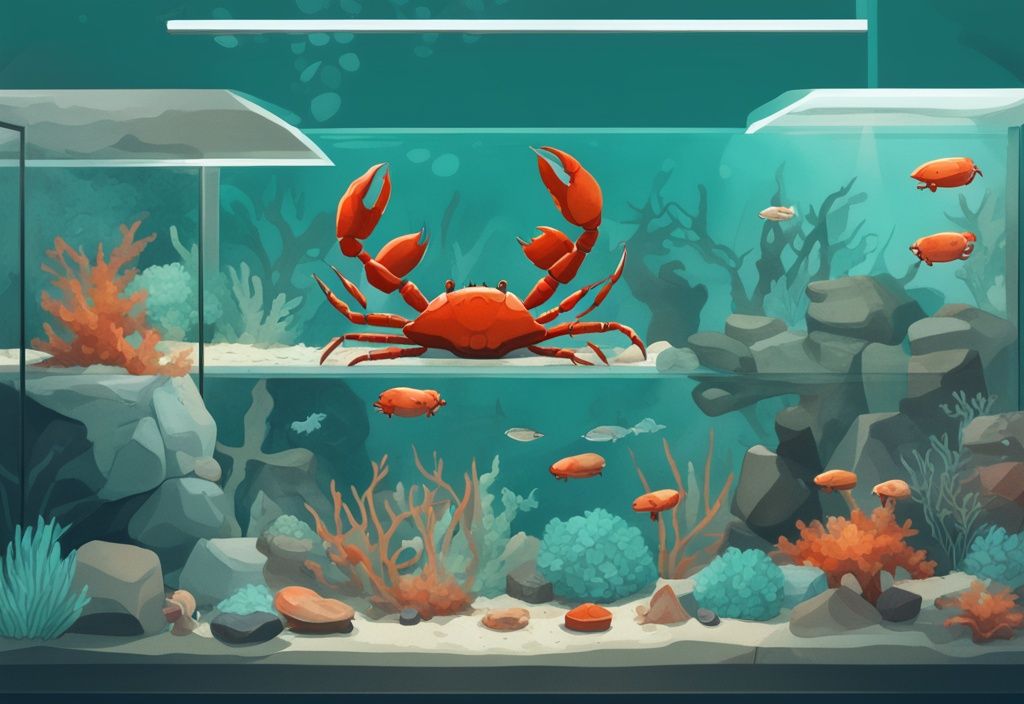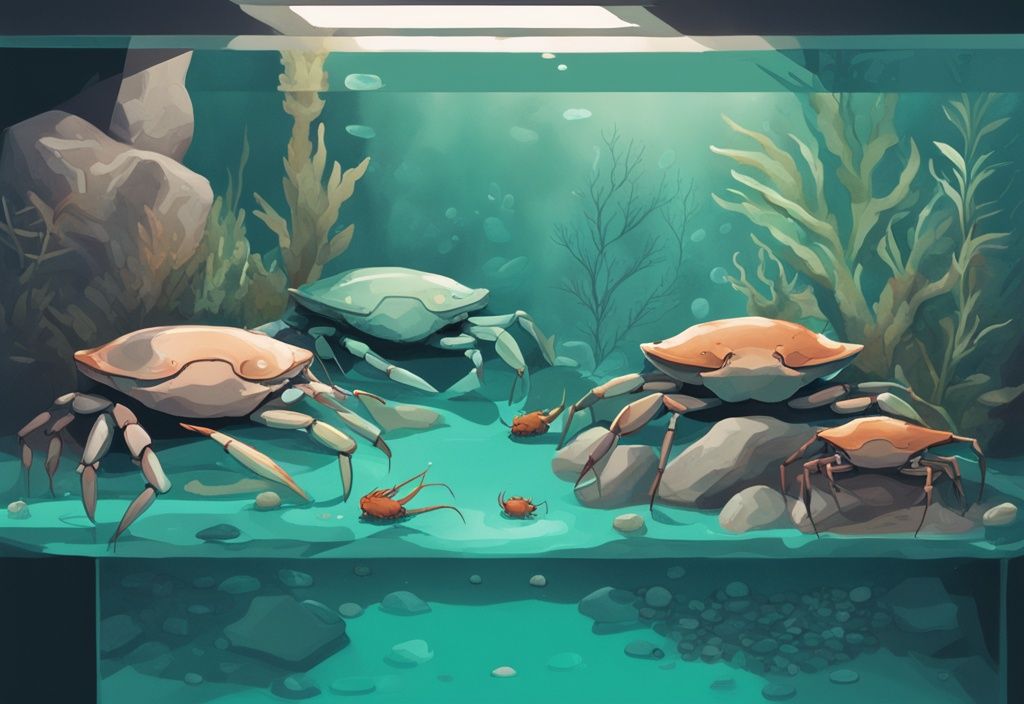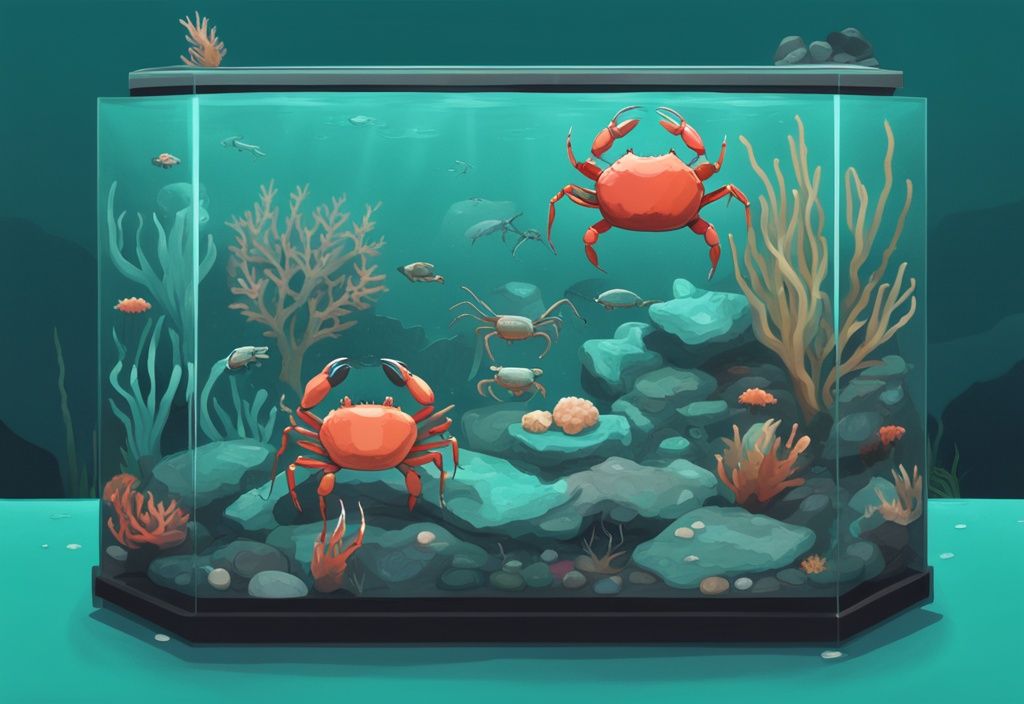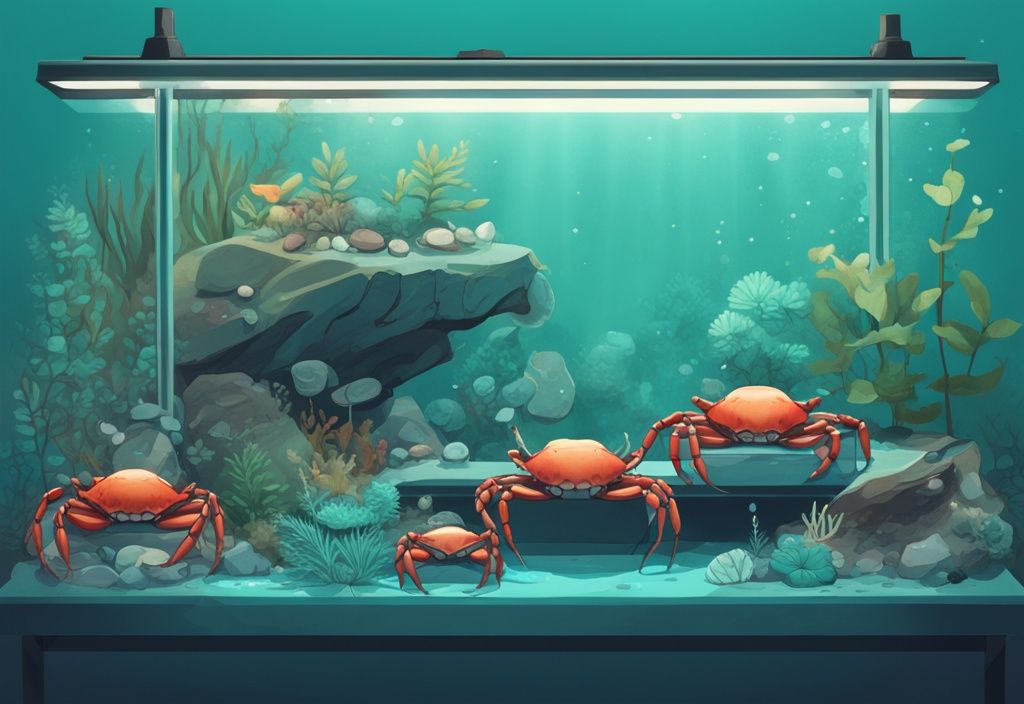Ultimate Guide to Crab Tank Setup: Essentials for a Thriving Habitat
Imagine your freshwater crab exploring a habitat that mirrors its natural environment, teeming with life and vitality. A poorly set up tank can be like a cramped apartment with no windows—hardly ideal for your aquatic companion. With over two decades of marine biology under my belt, I can assure you that a well-designed crab tank is crucial for their health and happiness. This guide will lead you through the essentials, from selecting the right tank size to maintaining water quality, ensuring your crabs thrive in a balanced ecosystem. Let’s dive in and create a sanctuary your crabs will adore!
Understanding Freshwater Crab Needs
Creating the perfect crab tank setup requires a deep understanding of the unique needs of various freshwater crab species. Each species has distinct environmental requirements that are crucial for their health and well-being. From aquatic to terrestrial habitats, the key lies in mimicking their natural surroundings as closely as possible.
Researching Crab Species
Understanding the specific needs of different crab species is crucial for a successful crab tank setup. Each species has unique requirements that must be met to ensure their health and well-being. For instance, hermit crabs thrive in land-based environments, necessitating a setup that mimics their terrestrial habitat. On the other hand, fiddler crabs require a semi-aquatic environment, combining both land and water elements to replicate their natural surroundings. It is important to note that not all freshwater crabs are fully aquatic; some species prefer paludarium setups, which offer a blend of aquatic and terrestrial features. Thorough research into the specific needs of your chosen crab species will guide you in creating the ideal environment for them.
Types of Crab Environments
Crabs can adapt to a variety of environments, each catering to different species’ needs. Fully aquatic setups are suitable for crabs that spend most of their time submerged, while semi-aquatic environments are ideal for species like fiddler crabs that require both water and land areas. Land-based setups cater to crabs that predominantly live on land, such as hermit crabs. Paludarium setups, which combine water and land features, are perfect for species that need both elements to thrive. When designing a crab tank setup, it is essential to replicate the natural habitat of the specific crab species. This involves considering factors such as humidity, temperature, and the availability of hiding spots and climbing structures. By ensuring the environment closely mimics their natural habitat, you provide the crabs with the best chance to thrive in captivity.
Choosing the Right Tank for Your Crab
When setting up a crab tank, selecting the right tank is a cornerstone of creating a thriving environment. This involves considering the tank’s size, material, and design to ensure your crabs’ health and happiness.
Tank Size and Dimensions
Selecting the appropriate tank size is crucial for the well-being of your crabs. Imagine your crabs as tiny explorers, each needing ample space to roam and claim their territory. Generally, larger tanks are preferable as they offer more room for the crabs to explore and establish territories. For smaller crab species, such as the Thai Micro crab, a minimum of a 5-gallon tank is recommended. However, if you plan to house 1-2 small crabs, a 10-gallon tank would be suitable. Larger or multiple crabs will require even bigger tanks to ensure they have ample space to thrive. It’s essential to research the specific needs of your crab species to determine the ideal tank size.
Tank Material and Design
When it comes to the material and design of your crab tank, a glass fish tank with a glass lid is the optimal choice. This setup helps maintain the necessary humidity levels and prevents the crabs from escaping. It’s important to ensure that the tank is fully enclosed to create a stable environment. Additionally, the design of the tank should prioritize length over height. Crabs are natural crawlers, and a longer tank provides them with more surface area to explore and engage in their natural behaviors. If you’re curious about other aquatic pets and their behaviors, you might want to learn more about why your betta fish might stay at the top of the tank. By focusing on these design elements, you can create a safe and comfortable habitat that closely mimics the crabs’ natural environment.
Creating the Ideal Habitat
Designing a crab tank setup is like crafting a miniature world where your crabs can thrive. This involves selecting the right substrate, adding decorations and hiding spots, and incorporating essential water features. Each element plays a crucial role in mimicking the crabs’ natural environment, ensuring their health and happiness.
Substrate Selection
Choosing the right substrate is akin to laying the foundation of a home. It’s vital for the well-being of your crabs. A minimum depth of 15 cm is recommended, allowing crabs to bury themselves completely. This depth caters to their natural digging instincts and offers a sense of security. Sand is often the go-to choice, thanks to its compatibility with crabs’ burrowing habits. Coconut fiber is another viable option. However, steer clear of soil substrates. They can cause pH imbalances and ammonia spikes, which are detrimental to your crabs.

Decorations and Hiding Spots
Crabs are natural climbers and hiders, so creating an environment that mirrors their natural habitat is essential. Think of it as designing a playground! Incorporate rocks, driftwood, and other decorations to offer climbing structures and hiding spots. Pebbles or sand at the bottom of the tank not only enhance its visual appeal but also create a natural setting. Adding hideaways and plants provides security and encourages interaction. Just ensure that all decorations are aquarium-safe to avoid introducing harmful substances.
Water Features and Pools
Water features are the heart of a crab tank setup. Crabs need both fresh and saltwater pools for activities like drinking, bathing, and maintaining shell water. These pools should be deep enough for the largest crab to fully submerge, supporting their natural behaviors. Regularly changing the water is crucial to maintain cleanliness and prevent harmful bacteria buildup. This practice ensures a healthy and thriving environment for your crabs.
Setting Up the Crab Tank
Creating an ideal habitat for your crabs involves careful planning and attention to detail. This guide covers essential aspects like location, cleaning, and enhancing your tank’s environment to ensure a thriving ecosystem.
Location and Placement
Finding the perfect spot for your crab tank is like choosing a cozy corner for a favorite armchair. Avoid direct sunlight to prevent overheating and algae blooms. Instead, aim for a location near a window or a light source, providing just the right glow for your crabs to thrive. Make sure the tank is close to an electrical outlet for equipment like filters and heaters. A sturdy, level stand is your tank’s best friend, especially if it’s on the larger side. Think of it as the foundation of a skyscraper—essential for safety and stability.
Preparing the Tank
Cleaning and Leak Testing
Before your crabs move in, give their new home a thorough scrub. Use safe cleaning agents like hydrogen peroxide to banish any harmful residues. Picture it as a spring cleaning ritual, ensuring a fresh start. Afterward, fill the tank with water and let it sit for 24 hours. This leak test is your insurance policy against unexpected waterworks, safeguarding your crabs’ habitat from disruptions.
Background and Insulation
Think of your tank’s background as its canvas. Painting it a dark color can make your crabs’ natural hues pop, turning your tank into a living masterpiece. Meanwhile, insulation mats are like cozy blankets, keeping the tank’s temperature just right. Consistent warmth is crucial for your crabs’ health, reducing stress and fostering a serene environment. With proper insulation, you’re not just maintaining a tank; you’re crafting a sanctuary.
Maintaining Water Quality
In a crab tank setup, water quality isn’t just a checkbox—it’s the heartbeat of your ecosystem. Ensuring pristine conditions is essential for the health and happiness of your crabs, and it involves a few key components that work together seamlessly.
Filtration Systems
Think of your filtration system as the unsung hero of your crab tank setup. It’s the diligent worker that keeps everything running smoothly, supporting the nitrogen cycle by breaking down waste products. Canister filters and hang-on-back filters are your best allies here. They’re not only efficient but also a breeze to maintain. Remember, a clean filter is a happy filter—give it a good scrub every one to two months, following the manufacturer’s guidelines for optimal performance.
Temperature and Humidity Control
Crabs are quite the divas when it comes to their living conditions. They demand a cozy temperature range of 75-85°F and a humidity level between 70-80%. To meet these needs, a thermometer and hygrometer are your trusty sidekicks, ensuring everything stays just right. A reptile heat mat or cord can be your secret weapon, providing the warmth they crave. This setup doesn’t just keep them comfy; it mirrors their natural habitat, encouraging their health and zest for life.
Water Cycling and Testing
Water cycling is the magic trick that transforms your tank into a safe haven. It’s all about nurturing beneficial bacteria to tackle harmful ammonia and nitrite, turning them into less toxic nitrate. This process is crucial to avoid ammonia spikes that could harm your crabs. A water testing kit is your best friend here, helping you keep an eye on ammonia, nitrite, and nitrate levels. Before welcoming your crabs, give it at least a week after cycling to ensure everything’s stable and ready for their arrival.
Lighting and Heating
Creating the perfect environment in your crab tank setup involves mastering both lighting and temperature. These elements are crucial for mimicking the natural habitats of your crabs, ensuring their health and happiness.

Simulating Natural Light Cycles
Imagine the gentle rhythm of sunrise and sunset, a dance of light and shadow that orchestrates the lives of creatures in the wild. In your crab tank setup, you can recreate this natural symphony by providing a light source that offers 12 hours of light followed by 12 hours of darkness. This cycle is vital for regulating the crabs’ biological processes, encouraging natural behaviors and overall well-being.
For species like red-clawed crabs, it’s fascinating to adjust the daylight hours seasonally—just as nature intended. During summer, aim for 10-12 hours of daylight, and in winter, reduce it to 8-10 hours. UVB lighting is your ally here, not only supporting this cycle but also boosting shell health and vitality. It’s like giving your crabs a little sunshine, even indoors.
Maintaining Optimal Temperature
Temperature control is the unsung hero of a thriving crab tank setup. Most freshwater crabs thrive in temperatures between 27-32°C. This range is their comfort zone, supporting their metabolic processes and keeping them lively.
Investing in reliable heating equipment, like aquarium heaters or heat lamps, is crucial. Regular checks with a thermometer ensure that the environment remains stable. Temperature fluctuations can stress your crabs, leading to health issues. By maintaining a consistent climate, you create a habitat that mirrors their natural conditions, promoting longevity and vitality.
Feeding and Nutrition
Dietary Needs of Crabs
Crabs are fascinating creatures with a penchant for a varied diet. As omnivores, they relish a mix of fruits, vegetables, and proteins, ensuring they get all the nutrients necessary for vibrant health. Think of their diet as a colorful salad bowl—leafy greens, carrots, and apples provide essential vitamins. Meanwhile, proteins like shrimp or fish pellets are their power bars, fueling growth and energy.
Now, here’s a quirky fact: hermit crabs, in particular, have a peculiar habit of changing shells. It’s like trying on new outfits! Providing them with natural, unpainted shells is crucial. Aim for at least six spare shells per crab, each differing in size and style, to cater to their ever-evolving fashion needs.
Feeding Schedule and Tips
A consistent feeding schedule is akin to setting a daily routine for your crabs. Regular meals not only guarantee they get the nutrition they need but also allow you to keep an eye on their eating habits—an excellent health barometer.
Feed them small portions once or twice a day, tweaking the amount based on their appetite. Remember, any uneaten food should be promptly removed to prevent water contamination, which could lead to murky waters and health woes.
Observing your crabs during mealtime is like attending a dinner party—it offers insights into their preferences, allowing you to fine-tune their menu.
Handling and Health Monitoring
Creating a harmonious environment in your crab tank setup involves both careful handling and vigilant health monitoring. These components are crucial for ensuring your crabs thrive in their aquatic home.
Safe Handling Practices
Handling crabs is akin to a delicate dance—one that requires both grace and confidence. Crabs, much like us, can feel stress, which might lead to defensive actions like pinching. To avoid this, handle them with a gentle touch, supporting their body fully without squeezing. Imagine cradling a fragile ornament; that’s the level of care needed. Additionally, quarantining new crabs before introducing them to your main tank is vital. This step prevents the spread of diseases and gives you a chance to observe any signs of illness or stress. Think of the quarantine tank as a cozy guest room, mirroring the conditions of the main tank to keep stress levels low during this adjustment period.
Monitoring Crab Health
Regular health checks are the backbone of a thriving crab tank setup. Keep an eye out for signs of illness or stress, such as lethargy, loss of appetite, or unusual behavior. These can be red flags indicating underlying health issues that need your immediate attention. Understanding the molting process is equally important. Crabs periodically shed their exoskeleton to grow, a vulnerable time when they need peace and quiet. Ensure your tank offers plenty of hiding spots, providing them with a sense of security during this sensitive phase. By monitoring these aspects, you’re not just maintaining a tank; you’re nurturing a vibrant, stress-free environment for your crabs.

Tank Maintenance and Cleaning
Creating a healthy environment in your crab tank is essential for the well-being of your aquatic companions. This section delves into the importance of maintaining cleanliness and the steps needed to ensure a thriving habitat.
Regular Cleaning Routine
Think of your crab tank as a small underwater world that needs regular attention to stay vibrant. Establishing a cleaning routine is like setting a rhythm for this world. Regular tasks, such as changing the water, removing uneaten food, and cleaning the substrate, are crucial. Water changes are the lifeblood of your tank, keeping the environment fresh and free from harmful bacteria. Uneaten food can quickly turn from a feast to a foe, decaying and contaminating the water. The substrate, often overlooked, is like the tank’s carpet—clean it to prevent waste buildup. By sticking to a consistent cleaning schedule, you ensure your crabs have a safe and thriving home.
Water Changes and Substrate Care
Water changes are more than just a chore; they’re a lifeline for your crabs. They help dilute nitrates, ammonia, and other toxins that can silently accumulate. Imagine it as a breath of fresh air for your tank. When changing the water, remember to rinse the substrate thoroughly. It’s like giving the tank a good shake to dislodge hidden debris, ensuring the water stays clear. This process not only cleans but also maintains a balanced aquatic environment. By managing water quality and substrate care diligently, you create a stable and inviting habitat for your crabs, promoting their overall well-being and longevity.
Conclusion
Embarking on the journey of a crab tank setup is a delightful adventure, even for those just starting out. With the right preparation and a touch of curiosity, creating a thriving habitat for freshwater crabs is well within reach. The secret lies in understanding the distinct needs of the crab species you choose. Each species brings its own set of requirements—be it tank size, substrate type, or environmental conditions—that need thoughtful consideration during the setup.
A suitable environment is vital for the health and happiness of your freshwater crabs. This means not only setting up the tank correctly but also committing to ongoing care and maintenance. Regular checks on water quality, temperature, and humidity are essential to ensure a stable habitat. Moreover, providing a varied diet and keeping the tank clean are crucial for the crabs’ overall well-being.
By adhering to these guidelines and staying attentive to your crabs’ needs, you can cultivate a vibrant and healthy crab tank. It’s a rewarding experience that brings both joy and a touch of the ocean’s wonder into your home.
FAQ
Setting up the perfect crab tank can be both an art and a science. Here, we dive into common questions to help you create a thriving environment for your freshwater crabs.
What size tank is best for freshwater crabs?
Imagine your crabs as tiny explorers needing their own little world. A 10-gallon tank is a cozy starter home for 1-2 small crabs. If you have larger or more adventurous crabs, think of upgrading their space. Always match the tank size to the species’ needs, ensuring they have room to roam and plenty of enrichment to keep them entertained.
How often should I clean my crab tank?
Picture your crab tank as a miniature ocean that needs regular care. Routine cleaning, including water changes and substrate maintenance, is crucial. This practice not only keeps harmful bacteria at bay but also creates a pristine environment where your crabs can thrive. It’s like giving them a fresh start every time!
Can different species of crabs live together?
Mixing crab species can be like hosting a dinner party with guests who may not get along. Some crabs enjoy company, while others prefer solitude. Research is key—ensure compatibility and keep a watchful eye on their interactions. This way, you can maintain a harmonious underwater community.
What should I do if my crab is molting?
Molting is a vulnerable time for crabs, akin to a caterpillar turning into a butterfly. During this phase, minimize disturbances and maintain a stress-free environment. Keep the tank conditions optimal, and your crabs will emerge stronger and more vibrant. It’s a natural process, so patience and care are your best allies.
